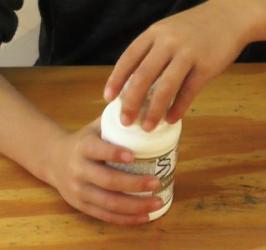Bimanual therapy or CIMT?
Sakzewski L. Bimanual therapy and constraint-induced movement therapy are equally effective in improving hand function in children with congenital hemiplegia. J Physiother. 2012;58(1):59.
Commentary on Gordon AM, Hung YC, Brandao M, Ferre CL, Kuo HC, Friel K, Petra E, Chinnan A, Charles JR. Bimanual training and constraint-induced movement therapy in children with hemiplegic cerebral palsy: a randomized trial. Neurorehabil Neural Repair. 2011 Oct;25(8):692-702.
"Constraint induced movement therapy (CIMT) has emerged as a promising upper limb rehabilitation approach for children with congenital hemiplegia. Until recently, CIMT has been compared to control groups receiving standard care or no treatment, raising questions whether improvements gained were a result of treatment methods or intensity of intervention (Sakzewski et al 2009). Gordon et al's (2011) results suggest the latter and confirm similar findings (Facchin et al 2011, Sakzewski et al 2011) that either intensive treatment approach leads to sustained improvement in upper limb function and achievement of individualised goals. Both approaches are goal directed and provide intensive repetitive task practice using incremental challenges to drive changes in upper limb function.
While results from either approach are similar, the interventions are not the same. CIMT changes the role of the impaired hand. It becomes the dominant hand with unimanual activities aimed to improve dexterity and efficiency of movement of that limb. It is assumed that gains in unimanual abilities will translate to improved bimanual performance, a premise supported by results of this study. In bimanual training, the role of the impaired upper limb remains as the assisting hand with therapy aiming to improve bimanual co-ordination and goal achievement through carefully tailored bimanual activities. Therefore, the choice of either approach will depend on a child's individual goals, and consideration of behavioural aspects (eg, tolerance of restraint)."
Overview articles
Charles J. Hand-arm bimanual intensive therapy: a new direction. Dev Med Child Neurol. 2017 Jun;59(6):569. doi: 10.1111/dmcn.13416. Epub 2017 Mar 8. PubMed PMID: 28272737.
"While changes in activity and participation are important elements to consider in determining intervention efficacy, other salient outcomes need to be considered. The proceedings from the Research SUMMIT III1 acknowledged that in addition to measures of activity and participation, neurophysiological and musculoskeletal components of movement impact impairment and need to be considered as factors that contribute to children with CP's ability to interact with their environment. In order to define the elusive dose response, future studies should include an expanded view of all factors that may contribute to changes from pre‐ to post‐intervention. Moving in a new direction that considers the whole child as well as children with a diagnosis other than unilateral CP would necessitate increased complexity in intervention methods and measures."
Hoare B, Greaves S. Unimanual versus bimanual therapy in children with unilateral cerebral palsy: Same, same, but different. J Pediatr Rehabil Med. 2017;10(1):47-59.
"The current emphasis on total dosage of practice for achieving positive outcomes fails to recognise the influence of other critical concepts within motor learning. Limitations exist in the application of motor learning principles using CIMT due to its unimanual nature. CIMT is effective for development of unimanual actions brought about by implicit learning, however it is difficult to target explicit learning that is required for learning how to use two hands together. Using bimanual therapy, object properties can be adapted to trigger goal-related perceptual and cognitive processes required for children to learn to recognise when two hands are required for task completion.
Basu, A. P., Pearse, J., Kelly, S., Wisher, V., & Kisler, J. (2015). Early intervention to improve hand function in hemiplegic cerebral palsy. Frontiers in neurology, 5, 281. doi:10.3389/fneur.2014.00281
Review articles
Chiu HC, Ada L. Constraint-induced movement therapy improves upper limb activity and participation in hemiplegic cerebral palsy: a systematic review. J Physiother. 2016 Jul;62(3):130-7.
This review suggests that constraint-induced movement therapy is more effective than no intervention, but no more effective than the same dose of upper limb practice without restraint.
Hoare BJ, Wallen MA, Thorley MN, Jackman ML, Carey LM, Imms C. Constraint-induced movement therapy in children with unilateral cerebral palsy. Cochrane Database Syst Rev. 2019 Apr 1;4
Home based intervention with parent training
Ferre, C. L., Brandão, M. B., Hung, Y. C., Carmel, J. B., & Gordon, A. M. (2014). Feasibility of caregiver-directed home-based hand-arm bimanual intensive training: a brief report. Developmental neurorehabilitation, 18(1), 69–74.
In summary, this study demonstrated that a home-based model of bimanual training using caregivers as interventionists is a feasible approach for improving hand function in children with USCP. A randomized trial examining this intervention model could provide an invaluable clinical intervention tool that could be used to target the deficits in children with USCP.
Ferre CL, Brandão M, Surana B, Dew AP, Moreau NG, Gordon AM. Caregiver-directed home-based intensive bimanual training in young children with unilateral spastic cerebral palsy: a randomized trial. Dev Med Child Neurol. 2017 May;59(5):497-504.
Baby CIMT
Lowes, L. P., Mayhan, M., Orr, T., Batterson, N., Tonneman, J. A., Meyer, A., … Case-Smith, J. (2013). Pilot study of the efficacy of constraint-induced movement therapy for infants and toddlers with cerebral palsy. Physical & occupational therapy in pediatrics, 34(1), 4–21. doi:10.3109/01942638.2013.810186
Karolinska Institure Baby CIMT Manual


